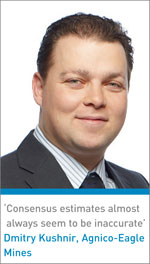Some IROs are compiling and publishing their own consensus figures, but others do not advocate the practice
National Grid in London does it, as do J Sainsbury and Kingfisher. And while some IR professionals are aghast at the notion that a public company might compile, compute and publish its own consensus estimates, a handful of practitioners have turned their backs on the Thomson Reuters and Bloombergs of this world and are doing just that.
IROs publishing their own consensus estimates tend to justify this bold step by pointing to the mistakes rife in the estimates already available. ‘In the UK, especially, the range of inaccuracies in earnings statistics is quite high,’ says John Dawson, IR director at National Grid. He believes the reporting latitude in IFRS could be one reason consensus estimates so often go awry.
Since May 2011, National Grid has compiled its own consensus earnings twice a year and emailed the results to a database of 1,500 individuals interested in following the company. Even IROs who don’t publish their own consensus numbers express frustration at the inaccuracies in the ‘consensus’. Dmitry Kushnir, IR director at Agnico-Eagle Mines in Toronto, is concerned that ‘consensus estimates almost always seem to be inaccurate.’
Even IROs who don’t publish their own consensus numbers express frustration at the inaccuracies in the ‘consensus’. Dmitry Kushnir, IR director at Agnico-Eagle Mines in Toronto, is concerned that ‘consensus estimates almost always seem to be inaccurate.’
Dawson suspects that 20 percent-30 percent of FTSE 100 companies calculate and publicize their own consensus estimates in one form or another, although he concedes the practice is ‘still not usual’.
Although National Grid does not post its own calculations on its IR site, Dawson notes that Cadbury, his previous employer, published its consensus estimates on the website for all to see.
Maintaining an objective perspective
National Grid, which uses input from 15-19 analysts for its figures, has created a transparent system for arriving at its numbers. ‘You’ve got to ensure you maintain a perfect audit trail as to how you’ve compiled the consensus,’ Dawson says.
‘We put appropriate disclaimers to ensure people understand it’s not the company’s view – it’s a reflection of a statistical compilation of the analyst estimates based on published information at a certain point in time.’
Specifically, National Grid asks all its analysts to complete the exact same template; the company then compiles the submissions and calculates a consensus. ‘This ensures there isn’t any inconsistency in definitions,’ explains Dawson. ‘The analysts know what they have submitted and you’re very clear on how you’re interpreting it.’
Kushnir finds the idea of a public firm calculating and publishing its own consensus earnings surprising – and a little dismaying. He’s convinced there’s ‘good reason’ most companies aren’t venturing into this terrain. ‘What’s the benefit to us?’ he asks. ‘Our business is to focus on operations, not to manage other people’s views of what our earnings will be.’
He also feels the media will still benchmark against the traditional consensus estimates, so the company’s own calculations wouldn’t have much punch. Bill Koefoed, general manager of IR at Microsoft, does not advocate publishing one’s own consensus estimates, but he does calculate consensus earnings estimates for each of the software giant’s five divisions by digging a little more deeply into the analysts’ reports.
Bill Koefoed, general manager of IR at Microsoft, does not advocate publishing one’s own consensus estimates, but he does calculate consensus earnings estimates for each of the software giant’s five divisions by digging a little more deeply into the analysts’ reports.
‘I’ll get questions about consensus on some of the segments within our businesses because the agencies don’t publish that,’ he explains.
The reluctance of most public firms to publish their own consensus estimates isn’t surprising given how heated the debate over earnings guidance can become, maintains Tom Enright, CEO of CIRI. He notes that even IROs game to offer earnings guidance often do so in a qualified way.
‘If a company gives guidance, it may be annual and a range rather than specific numbers,’ he says. ‘Or it may give guidance on certain performance indicators, not on earnings. It varies quite a bit.’
Correcting the record
Where IROs don’t publish their own consensus estimates, this doesn’t imply that they don’t track the numbers internally – and sometimes take action.
‘If there’s a substantial problem, it’s worth trying to get it changed, especially if consensus is based on a small number of analysts,’ says Dawson. ‘But if you have lots of analysts, even if there’s a factual error, it tends to be lost in the detail.’
Kushnir usually reviews the details of consensus several weeks before the end of each quarter. ‘Often we’ll say, Wait a minute, this looks like it’s a big outlier,’ he says. ‘We then find the latest piece of research from that analyst and make sure it’s correct.’
When problems arise, Kushnir finds contacting the relevant firms and providing a link to the most up-to-date analyst report usually gets results within 24 hours.
More complicated are situations where the analysts’ numbers are off, although if the number of shares outstanding or commodity prices is wrong, calling the analyst and getting the numbers fixed can be the best option, Kushnir adds.
At other times, numbers differ because the methodologies used by analysts and the firms diverge. For example, analysts typically forecast normalized EPS, excluding one-time items, while companies are required to report EPS according to the prevailing accounting rules.
Enright likens communicating with the firms that calculate consensus estimates to dealing with proxy advisories because, in both cases, establishing an ongoing dialogue is best practice.
‘If you’re meeting with analysts regularly, you can help them understand your company better and help correct some of the factual inaccuracies,’ he says. ‘Nothing beats having those relationships in place.’
Although IR professionals appreciate accurate consensus estimates, their overall importance may be declining thanks to the wealth of information out there. It’s now conventional wisdom that the buy side depends less on published consensus because savvy investors have the means to calculate earnings estimates for themselves.
‘The estimates are still important,’ concludes Enright. ‘But they’re less important now than they were years back, when there wasn’t as much information available in the marketplace.’
Is there any consensus on consensus?The notion of ‘consensus’ is something of a misnomer given the competing estimates floating around. Bill Koefoed, general manager of IR at Microsoft, points out that major companies like Thomson Reuters, FactSet, Bloomberg and StreetAccount each publish slightly different numbers.‘We try to make sure there’s consistency in the earnings estimates across all the agencies,’ he says. ‘It’s challenging that there are four consensuses out there, and they do differ sometimes. We don’t have our own view, but we probably have the most complete view because I have all the sell-side analysts’ estimates, and we have 36 firms following us.’ Unsurprisingly, those issuing consensus estimates view things slightly differently. Sri Raman, senior research analyst at Thomson Reuters, trusts in the process, noting that on average the numbers are accurate. ‘There might be over-optimistic analysts and over-pessimistic analysts, but most of them get it right for most of the firms,’ he says. John Scherr, president of WhisperNumber.com, an independent financial research firm that collects earnings expectations from the investment public, takes a dimmer view. He argues that the frequency of positive earnings surprises shows the numbers are not pure calculations but rather ‘a cyclical tango between analysts and companies.’ He adds that for the past 52 quarters, 60 percent of S&P 500 companies have beaten expectations. ‘Positive surprises are universal,’ he notes. ‘There’s no true consensus estimate out there, just a game of analysts lowering expectations and maybe companies guiding those expectations lower so they can be beaten quarter in, quarter out.’ And it seems even the traditional consensus estimates are open to tweaking. Raman says Thomson Reuters now publishes a ‘smart estimate’, which gives greater weight to recent estimates and estimates from analysts with a five-star rating (based on their track record for accuracy). He says many media outlets, including CNBC, now quote this ‘smart estimate’ alongside the traditional estimate. |










